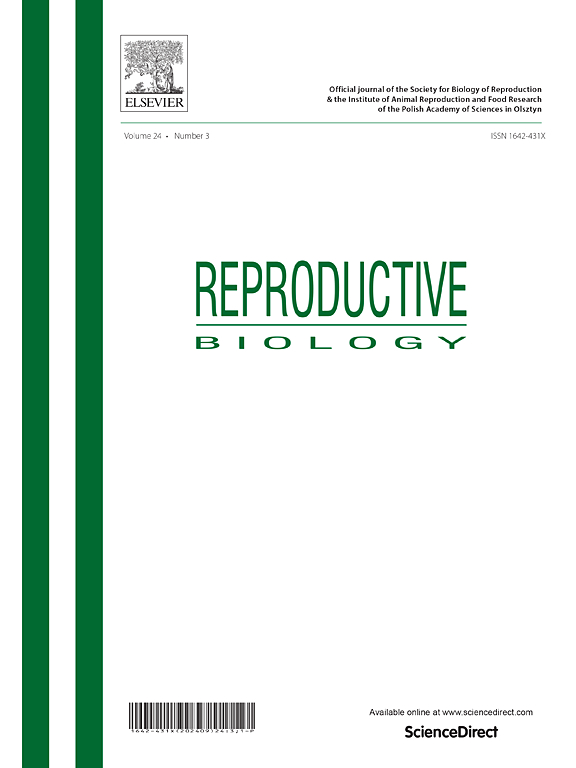PCOS and genetics: Exploring the heterogeneous role of potential genes in ovarian dysfunction, a hallmark of PCOS – A review
IF 2.5
3区 生物学
Q3 REPRODUCTIVE BIOLOGY
引用次数: 0
Abstract
PCOS is an endocrine disorder that affects women of reproductive age. The root of PCOS is ovarian dysfunction, which presents as hormonal disturbances affecting normal ovarian function to cause the symptoms and complications of the disease. This dysfunction causes symptoms like impaired maturation of follicles and disorders of various origins with multiple treatment regimens that are not always clear. Therefore, the present review mainly concentrates on the genetic level of ovarian dysfunction of PCOS. The articles were identified through a vigorous literature search where search engines such as PubMed, Google Scholar, databases, and Science Direct were used, and the articles published from 2015 to 2025 were referred. We identified that the key genes involved in the ovarian dysfunctions in PCOS include CYP11A1, CYP17A1, CYP19A1, AR, FSHR, LHCGR, AMH, INSR, SHBG, IRS1, GATA4, ADIPOQ, YAP1, TCF7L2, and DENND1A, which play a role in gonadotropin action, steroidogenesis, and folliculogenesis. Furthermore, epigenetic factors and miRNAs miR-93, 222, 155, 146a, 132, 320, 27a, 483, 21, 378, 17–92 Cluster, and 375, 221 are also involved in it. Abnormal expression of these genes is known to play a critical role in the etiology and pathogenesis of PCOS. Present treatment includes the use of oral contraceptives, anti-androgen agents, insulin-sensitizing agents, and ovulation-inducing agents, and future treatment may consist of miRNA therapy, drug repositioning, and genetic markers that might be used for early identification and better management of ovarian dysfunction. Thus, the current review discusses ovarian dysfunction in PCOS, the involvement of potential genes and epigenetic factors, and miRNAs concerning ovulation and its therapeutic implications.
多囊卵巢综合征与遗传学:探讨多囊卵巢综合征的一个标志——卵巢功能障碍中潜在基因的异质性作用-综述
多囊卵巢综合征是一种影响育龄妇女的内分泌紊乱。多囊卵巢综合征的根源是卵巢功能障碍,表现为激素紊乱,影响卵巢正常功能,引起多囊卵巢综合征的症状和并发症。这种功能障碍导致诸如卵泡成熟受损和各种来源的疾病等症状,多种治疗方案并不总是很清楚。因此,本文主要就PCOS卵巢功能障碍的遗传水平进行综述。通过PubMed、b谷歌Scholar、database、Science Direct等搜索引擎,检索2015 ~ 2025年发表的论文,进行了文献检索。我们发现与PCOS卵巢功能障碍相关的关键基因包括CYP11A1、CYP17A1、CYP19A1、AR、FSHR、LHCGR、AMH、INSR、SHBG、IRS1、GATA4、ADIPOQ、YAP1、TCF7L2和DENND1A,这些基因在促性腺激素作用、类固醇生成和卵泡生成中发挥作用。此外,表观遗传因子和mirna miR-93、222、155、146a、132、320、27a、483、21、378、17-92 Cluster和375、221也参与其中。已知这些基因的异常表达在多囊卵巢综合征的病因和发病机制中起关键作用。目前的治疗包括使用口服避孕药、抗雄激素药物、胰岛素增敏剂和促排卵剂,未来的治疗可能包括miRNA治疗、药物重新定位和遗传标记,这些可能用于卵巢功能障碍的早期识别和更好的管理。因此,本文将讨论PCOS患者的卵巢功能障碍、潜在基因和表观遗传因素的参与、与排卵有关的mirna及其治疗意义。
本文章由计算机程序翻译,如有差异,请以英文原文为准。
求助全文
约1分钟内获得全文
求助全文
来源期刊

Reproductive biology
生物-生殖生物学
CiteScore
3.90
自引率
0.00%
发文量
95
审稿时长
29 days
期刊介绍:
An official journal of the Society for Biology of Reproduction and the Institute of Animal Reproduction and Food Research of Polish Academy of Sciences in Olsztyn, Poland.
Reproductive Biology is an international, peer-reviewed journal covering all aspects of reproduction in vertebrates. The journal invites original research papers, short communications, review articles and commentaries dealing with reproductive physiology, endocrinology, immunology, molecular and cellular biology, receptor studies, animal breeding as well as andrology, embryology, infertility, assisted reproduction and contraception. Papers from both basic and clinical research will be considered.
 求助内容:
求助内容: 应助结果提醒方式:
应助结果提醒方式:


